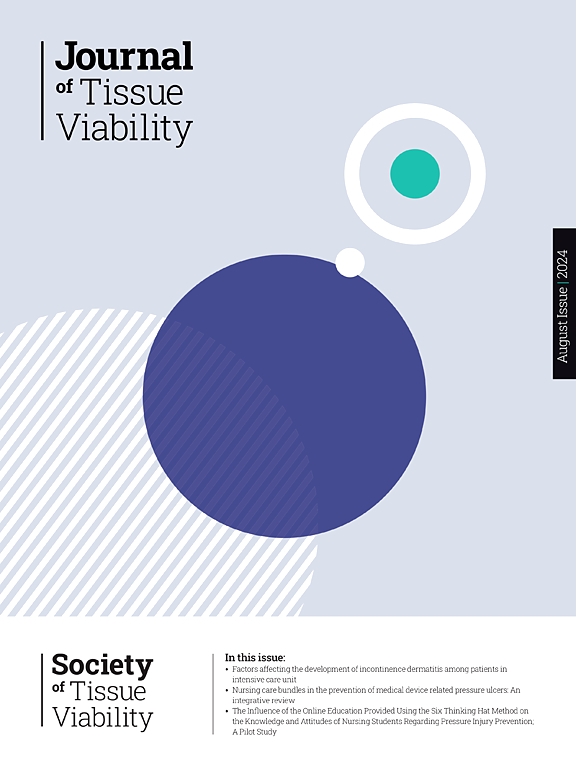Exploration of current practice and context for the prevention and treatment of incontinence associated dermatitis for adults living in care homes and community settings: a qualitative study
IF 2.4
3区 医学
Q2 DERMATOLOGY
引用次数: 0
Abstract
Aims
This study aimed to explore current practice and context for the prevention and treatment of incontinence associated dermatitis (IAD), identify challenges and solutions, current prevention and treatment strategies, and products used.
Materials and methods
Using a qualitative cross-sectional approach online focus groups were conducted with stakeholders including experts by experience of IAD (n = 5) and health/care professionals (n = 16). Verbatim transcripts were coded independently by two researchers and analysed using framework analysis.
Results
Four themes and two sub-themes were identified: (1) Impact of IAD: “significant” damage could occur in a short space of time; (2) Uncertainty, is it IAD? Correct diagnosis of IAD was challenging, especially in people with black skin. Uncertainty was underpinned by a lack of education and clear guidance on skin inspection. (3) Lack of resources (sub-themes human resources and product resources): Lack of human resources related to the number of staff available, deficiency of knowledgeable and skilled staff, and limited leadership. Lack of availability of pads was a challenge and carers reduced the number of pad changes to “conserve pads”; (4) Variation in practice, both for cleansing skin and applying a leave-on ‘barrier’ product.
Conclusion
Care for adults with incontinence to prevent and/or treat IAD is challenging in the social care sector. Wide variation in practice exists and there is a need for educational interventions in the sector, targeting an international and transient workforce.
探索目前的实践和背景,预防和治疗失禁相关性皮炎的成人生活在养老院和社区设置:一项定性研究
本研究旨在探讨目前预防和治疗尿失禁相关性皮炎(IAD)的实践和背景,确定挑战和解决方案,当前的预防和治疗策略以及使用的产品。材料和方法采用定性横断面方法与利益相关者进行在线焦点小组讨论,包括经验丰富的IAD专家(n = 5)和卫生/保健专业人员(n = 16)。逐字记录由两名研究人员独立编码,并使用框架分析进行分析。结果确定了四个主题和两个副主题:(1)网络成瘾的影响:在短时间内可能发生“重大”损害;(2)不确定性,是IAD吗?对IAD的正确诊断具有挑战性,特别是对黑皮肤人群。缺乏对皮肤检查的教育和明确指导,加剧了不确定性。(3)资源缺乏(分主题人力资源和产品资源):人力资源缺乏与现有员工数量、缺乏知识和技能的员工以及有限的领导有关。缺乏可用的护垫是一个挑战,护理人员减少了更换护垫的次数,以“保存护垫”;(4)实践上的差异,无论是清洁皮肤还是使用免洗“屏障”产品。结论对成人尿失禁进行预防和/或治疗在社会护理领域具有挑战性。在实践中存在着广泛的差异,需要在该部门进行教育干预,以国际和流动劳动力为目标。
本文章由计算机程序翻译,如有差异,请以英文原文为准。
求助全文
约1分钟内获得全文
求助全文
来源期刊

Journal of tissue viability
DERMATOLOGY-NURSING
CiteScore
3.80
自引率
16.00%
发文量
110
审稿时长
>12 weeks
期刊介绍:
The Journal of Tissue Viability is the official publication of the Tissue Viability Society and is a quarterly journal concerned with all aspects of the occurrence and treatment of wounds, ulcers and pressure sores including patient care, pain, nutrition, wound healing, research, prevention, mobility, social problems and management.
The Journal particularly encourages papers covering skin and skin wounds but will consider articles that discuss injury in any tissue. Articles that stress the multi-professional nature of tissue viability are especially welcome. We seek to encourage new authors as well as well-established contributors to the field - one aim of the journal is to enable all participants in tissue viability to share information with colleagues.
 求助内容:
求助内容: 应助结果提醒方式:
应助结果提醒方式:


